[Jim Bridwell died the morning of February 16, 2018, after suffering from illness. He was 73. The family has started a fundraising campaign on GoFundMe.com to help cover medical costs. Contributions can be made there, and readers can find more details about the events that led to his passing.–Ed]
This story first appeared in Alpinist 18.
First Climb, Rio de Janeiro: The 1950s
Sunlight glistened along the lizard’s back like water. Each time I reached for it, it darted, quick as a minnow, higher up the rock, swimming over bulges and through the cool shadows of small cracks. I was six or seven. I’d always liked watching small animals, but the lizard absolutely mesmerized me. Now, it wriggled out of reach. I touched the rock, wishing my hands and feet could stick to the granite flakes like the tiny creature’s did, and then, without thinking, I began to climb after it, farther and farther up the cliff. From time to time the lizard stopped, as if to lure me on.
My foot slipped a little on a loose patch, and I looked down. In the dirt lot beneath me, everything had gotten smaller. There was no one around. I began to shake. The lizard was gone. A shadow seemed to pass over the bright day. Slowly I relaxed my tight grip on the handhold above me and moved my trembling fingers to the one below it. Then the other hand, then a foot, reversing the moves. The same terrain that I’d passed over, hypnotized by the lizard’s easy movements, had grown steeper, the holds harder to find.
When my feet struck the ground, I stumbled backward, the horizontal world unfamiliar. My anxiety subsided, and I imagined the lizard, high on the cliff, looking down at me, its slim body quick as a wink.
For years the memory of that beauty and that fear fermented in me until I realized it wasn’t about the lizard. I wanted to capture something that was even more elusive: I wanted to find the limits of my imagination itself.
Yosemite: The 1960s
I was seventeen, and I didn’t even have climbing shoes. Walls billowed and crested above the forests in colossal waves of granite. I felt dizzy with anticipation. Inevitably my pursuit had brought me to Yosemite; in the 1960s it was the center of free climbing in America, a close and somewhat guarded community. There wasn’t a guidebook to the Valley then; route information spread by word of mouth, and it took a while for a new face to gain admittance. But traveling the way I had–my dad was a pilot in the military–I was used to being the new kid.
I hung out at the climbers’ campsites, listened to them talk about their routes, followed them to the base of the walls. Occasionally, I was invited to go bouldering. When I went home to San Jose a week later, I got a job shoveling chicken shit and earned enough money to buy shoes. I recruited high school friends to climb on local crags and practice rope skills.
Back in Yosemite that winter, everyone was talking about the Dihedral Wall. Two relative outsiders, Ed Cooper from Seattle and Jim Baldwin from British Columbia, along with the more established local Glen Denny, were putting up the third major route on El Cap–and some Valley climbers, like Royal Robbins, were annoyed by their siege-style tactics. Climbing fast and efficiently, using fixed ropes as rarely as possible, had become the new ideal. As much as they liked hard-drinking, bawdy Jim Baldwin, his approach seemed like a setback.
“Hey Jim,” Baldwin said to me, when I showed up in the campground; his voice came out deep and rough from behind his thick beard, and his eyes flashed mischievously under big glasses. “When d’ya get back?” It was the first time a Valley resident had called me by name.
The next spring I would go with several others to the base of the Washington Column to carry Jim’s body out after he rapped off the end of his rope in the dark and fell hundreds of feet onto talus. From the tense faces and reddened eyes of the climbers around me as we lifted him rose a sense of deep, abiding brotherhood. Afterward, each time I rappelled, I thought of Jim. I determined never to let my awareness lapse and always to be self-reliant.
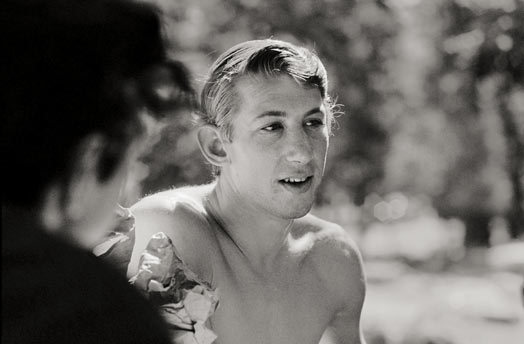
Jim Bridwell in Camp 4, ca. 1964, when finding a partner was still hard for him. Forty years later Bridwell is credited with nearly eighty first ascents in the Valley; he also helped found the Search and Rescue Team in 1967 and introduced the “a, b, c, d” subgrading of the Yosemite Decimal System. [Photo] Glen Denny
“Are you free climbing?” Layton Kor yelled down to me. Layton didn’t believe in wasting time.
“Yeah,” I said.
“You little bastard,” he said, laughing. Layton was so full of good-natured energy, striding around the campsite, running his words and ideas together as he talked, telling dirty jokes, stupid jokes, devouring food, pursuing women, speeding up one route after another, sending wall after wall (including the fourth new route up El Capitan, the West Buttress, 1963, with Steve Roper), until he ran out of partners, then grabbing anyone he could find to climb with him, even me. When he and I had freed Rixon’s Pinnacle Far West Side, he’d buffaloed the leads; six foot five inches tall, he’d said, in a dead-serious tone, “This is a scary pitch and height makes a lot of difference.” I won my first pitch from him that day on Left Side of the Folly. Near the top an offwidth turned into a squeeze chimney, and big-chested Layton stared at my skinny-little-kid frame. “Hey man,” he said, in a resigned voice. “How ’bout you take this one?” I’d been waiting for such an opportunity.
I squirmed quickly up the pitch, proud that for once I wasn’t just cleaning his pitons. Layton was my first mentor, and he taught me the value of speed. A “just-get-up-the climb” kind of climber, to Layton anything was fair–pull on a sling, step on a piton, whatever got you moving faster. Years later, in the mountains, I would value that lesson.
Layton wasn’t the only one who’d begun to invite me climbing. That summer, 1964, I found myself finally accepted into the elite circle, where an elegant wardrobe of bakers’ pants (50 cents) and a white dress shirt (35 cents), purchased from a nearby Merced thrift store, was the unwritten dress code. Any time I got the chance to go with hard climbers like Kor, Chuck Pratt and Frank Sacherer, I tried to learn whatever I could.
I felt especially lucky when Frank asked me to do the North Buttress of Middle Cathedral, an old Harding aid route. Frank was far more selective about his partners than Layton was, and here was a chance to join up with the driving force in modern free climbing. Evening after evening, it seemed, the freckly, stern, twenty-four-year-old Sacherer would arrive in Camp 4 to eager audiences awaiting his latest aid eliminate or one-day ascent, visionary feats that seemed impossible to the best climbers of the day. But if Layton exhausted his partners, Frank terrified them: he called both Eric Beck and Steve Roper “chickenshits” on separate occasions–Beck for pleading with him to place a piton as Sacherer climbed, protectionless, high above the belay stance, and Roper for backing off a sixty-foot runout on the Crack of Doom.
Soon I learned for myself what being his partner meant. At the base of the North Buttress, he sized me up. “I don’t know if you can do this, but we’ll soon find out,” he said, and then he took off up the climb, unroped. I soloed after him, cautiously, until we reached the first aid eliminate and he allowed me to tie in. We unroped again as the pitches grew easier near the top. “Don’t fall here,” Frank warned me, “because I’ll never hear the end of it.”
We eliminated all four aid pitches on the North Buttress in five and a half hours, including three pitches of 5.10, the highest level at the time. I must have pleased him, for we went on to do the second free ascent of Crack of Doom together. “You’re the best partner I’ve had this summer,” he told me. I was flattered–and inspired: such dangerous values would color my climbing for years to come. When Steve Roper left for Europe, he informed me, “You’ll probably be dead when I get back.”
It seemed as though all Frank had to do was simply envision something wild and it came true. “I want to do the Nose in a day,” he said one night in Camp 4. If anyone else had said it, all the residents would have laughed. Instead we listened with awestruck silence, as Frank explained that if the Stovelegs Cracks went free, the remainder could be done in under twenty-four hours. In 1964 he took me on a reconnaissance of that pitch, and a year later, when he left to pursue his physics career, I felt as though he’d willed his vision, and the Valley, to my generation.
Interlude: Camp 4, late 1960s-1970s
And what a bequest: the hippie era and the free-climbing revolution were both in full swing. At Camp 4 we purloined the Park electricity, running an electric cable from the bathrooms to my Arabian-style tent, where we hosted an almost continuous party, playing Jimi Hendrix, Bob Dylan, the Rolling Stones. In exchange for helping to organize the first official rescue squad, the rangers let me and my friends stay for free–and for the time being, left us alone.
Yvon Chouniard began manufacturing nuts, and aid climbers started doing pitonless ascents, while talented free climbers pushed the grades ever higher, through 5.10a, b, c and d, and finally the unbelievable 5.11. Purists like Royal Robbins and Henry Barber perfected a ground-up, meet-the-rock-on-its-own-terms ethics. Ray Jardine, on the other hand, introduced hangdogging and 5.12, along with the first working models of the spring-loaded camming device, creating the possibility for harder and harder trad routes.
Although I joined Barber to bag the second free ascent of New Dimensions, the Valley’s first 5.11, I also kept honing my aid skills, which still seemed necessary for big-wall climbing. El Capitan and the Nose remained my goal.
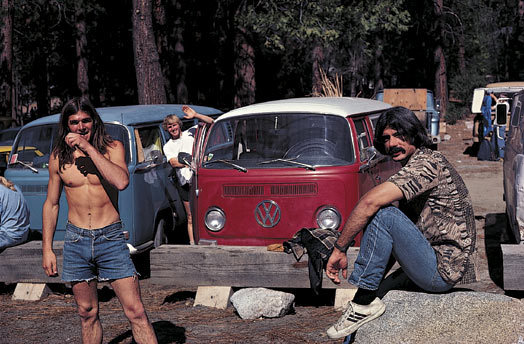
The center of the universe, ca. 1975: from left to right, Ron Kauk, John Bachar and Mark Klemens in the Camp 4 parking lot. By the early 1970s, Bridwell, influenced by a Yvon Chouinard article, had started looking at the Valley as a training ground for big climbs in remote venues. [Photo] Jim Bridwell
My First Big “Wall”: Aquarian Wall, 1971
When you first look up at a big wall, the immensity of the rock weighs down on you; but once you break contact with the ground and get high enough, it begins to feel lighter and lighter, as though with the shift in perspective, the laws of gravity can change. In 1969 as Kim Schmitz and I wandered around the base of El Capitan with binoculars, we struggled to see the furrows and blemishes within its monolithic bulk and strained our imaginations to turn them into lines that could be created without too much drilling. At first the lower third of the wall appeared smooth, but on closer inspection, a series of arches emerged.
Kim was even younger than I was, and a little quieter, but we shared the same ambition. At the time there were only a few routes on El Cap; all their first ascensionists were famous climbers. Like me, Kim was a relative newcomer to the Valley–he’d learned his efficient aid climbing skills in Smith Rocks (which in the days before sport climbing was known for aid). We felt not only the weight of the great stone, but also that of the names of our predecessors: Harding, Robbins, Kor, Frost.
We crept up the wall, intimidated, using small loops of webbing that we draped over nubbins, tips of the newly developed Leeper Z pitons that just held my bodyweight, and when we could find nothing else, aluminum dowel bolts that we hammered into shallow holes. The smallest mishap would send Kim into a panic; once I heard him screaming, only to find out nothing was wrong other than some rope drag that had caused his swami belt to cut into his waist.
But in our Mexican beach hammocks, strung between two anchors, we lay back and enjoyed the October sunset, basking in the knowledge that we’d crossed a vast slab already, with only forty bolts and dowels–until the glowing cumulous clouds turned from beautiful to menacing. Wind battered us against the wall, tearing apart our hammocks. In that short space winter had arrived. The next morning we rappelled straight down, our spirits crushed. Yet we left behind two gallons of water at our high point–a sign that we intended to return.
The water went bad; all the next summer and fall, the heat kept us cowering and grumbling on the ground as other climbers attempted our route. Finally the second spring, my arm still weak from a skiing accident, I grew sick of waiting to heal, and Kim and I passed another team’s high point. They’d left behind an unusual piece of equipment: a fishing pole with a skyhook attached that they’d been using to reach past hard aid placements to the bolts above them. I was determined not to let technology mediate between me and my own direct experience of the wall.
During the remaining time it took to complete the route, we’d indeed feel the full force of the elements: a drip of rain became a waterfall, filling our Bat Tent with four inches of water, then turned to enormous snowflakes so cold my hands grew purple and swollen, and we had to nail back down. In late June, when the weather improved again, we came to what we named Coral Corner: calcium formations that tore our fingers and clothing. Silverfish wriggled over the rock, as if the stone had come alive. A last, 5.9 A1 pitch baffled me, each placement expanding or bottoming out. The haulbag swung and got stuck on a ceiling sixty feet to the right of the route. With loud curses, I dropped it, traversed across to the West Buttress and topped out.
The sense of weight had lifted; on future ascents we’d move faster and lighter. We called our route Aquarian Wall, put up during the “age of Aquarius.” Robbins made it clear that what we’d climbed was not actually a “wall,” but who was he to tell us what to name our route? Although we admired him and his high standards, we were beginning to feel that it was our generation’s turn to improve them. And if he had named his routes “walls,” why couldn’t we?
The Nose in a Day: June 21, 1975
The full moon lit up the south buttress of El Capitan: shades of silver, gray and black rippled up 3,000 feet to the sky. At 4 a.m. we started, without our headlamps, climbing by moonlight and memory–we’d already rehearsed the first four pitches and knew every move and every nut and pin placement by heart. With us we had three nine-mil ropes of uncertain age and condition, twenty-five nuts, twenty-five pitons and one and a half gallons of water.
It had been eleven years since Frank had first given me the idea, and eight years since I’d freed the Stovelegs pitch with Jim Stanton; in the meantime, I’d been too caught up in my own first ascent projects to go back. But that spring, I’d started feeling the lure of alpinism. I’d read a Chouinard article in which he’d described Yosemite not as an end in itself, but as training ground for big walls in the Greater Ranges, where the future of climbing lay. Around the same time, Frost had persuaded me that pure technical difficulty wasn’t enough; there had to be something else to climbing, a level of commitment and adventure that made it spiritual. While climbers like Robbins seemed to go too far in making the sport into a quasi-religion, I was curious, dabbling like a lot of the others in my generation in Buddhism and Hinduism. I didn’t want to be just a rock climber; the high mountains seemed to offer something more, and I felt that speed meant safety up there. A month before, as Bill Westbay, Jay Fiske, Fred East and I finished opening the Pacific Ocean Wall, probably the hardest aid climb in the world at the time, I realized that the key to alpine big walls for me would be the ability to use aid through sections I couldn’t free quickly. And I became sure that I had the patience, skill and creativity to get through any obstacle.
I had begun to think about Cerro Torre in Patagonia; the Nose in a day would be good preparation. I haunted the Mountain Room Bar, searching for the right partners. More and more climbers now filled the Valley, and I had a lot to choose from. One promising candidate was John “Largo” Long, to whom Jim Donini had introduced me in 1970, when John had arrived in the Valley as a brash, naive young climber with an ambitious ticklist. John told me he’d heard I did sets of a hundred pull-ups, tore three phone books in half at once and pulled a stop sign out of cement to throw at a car that wouldn’t pick me up hitchhiking. I had a good laugh over such myths, but belaying John up his first offwidths, I’d been impressed by his determination, and we’d become good partners. I knew his strength and large hands would be perfect for the wide cracks in the segment between the Sickle Ledge and the Boot Flake.
I also recruited Billy Westbay, a climber from Colorado, talented at switching between aid and free. Billy agreed to take the middle part of the route, which was a combination of the two. Finally, I figured we’d all be too tired for free climbing by the time we reached Camp Five, and as I’d worked on improving my nailing skills over the past few years, I was the obvious choice for the last pitches to the top.
I’d developed a system in which we’d lead in “blocks”: the leader trailed one rope and led on another. The second man cleaned the gear, while the third jumared the trail rope, as quickly as he could, dragging another rope. When the third person arrived at the belay, he switched the rope ends with the leader, who then set off on the next pitch. In theory, this system would allow the leader sufficient time to smoke a cigarette and light another for the next belayer. With thirty-four pitches ahead of us, we rationed ourselves to a pack and a half each. It would be a vertical run on a Midsummer Night, the longest day of the year.
Shortly before we began, we found out that another party planned to be on the route before us. Worried that we might get stuck behind them and lose time, John walked over to their campsite. “You guys better get the hell outta the way and let us pass,” he said. “Or else.” Typical Largo diplomacy.
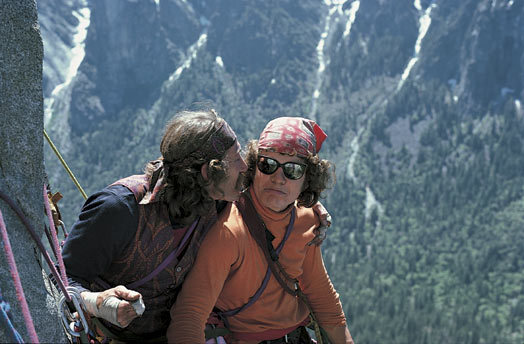
Bridwell and John Long, joking around on their fifteen-hour 1975 Nose-in-a-day climb. Frank Sacherer had suggested the project in the mid-1960s, but it took a decade for Bridwell, Long and Billy Westbay to bring it to fruition. [Photo] Billy Westbay
6:15 a.m.: the two climbers John had tried to scare were bivying on the top of Dolt Tower. They woke to see us emerge in our purple and pink double-knit pants and paisley and African print shirts–our attempt at an ironic, Yosemite avant-garde uniform. We must have been a strange apparition: already bedraggled, panting, wild-eyed. We’d left two nuts behind, forgotten in a moonshadow. I’d been so absorbed in climbing fast that I hadn’t even noticed the dawn; I’d merely felt the increased heat, peeled off my sweater and thrown it into the void.
“Where’s your haulbag?” one of them asked, looking around him with glazed eyes. I pointed to the small rucksack on my back.
John had been training hard for this climb; although free climbing that section had become ordinary by then, his short-shrifting of protection in favor of speed astonished us. Soon he was clipping his way toward the Boot Flake, four pitches higher, his thirteenth lead. My own muscles were starting to cramp from the relentless pace. Without pausing, however, John left the final bolt and went straight into a committing lieback. Neither Billy nor I realized John’s arms were cramping, too, until his handjam began to slip. His free hand shaking with effort, he stuffed a hex into the crack and clipped into it just in time to avoid an eighty-footer.
Billy took over the lead. He made the King Swing pendulum on his first try and then headed into doubtful, wandering sequences, reminiscent of his home crags in Colorado. Pitches rolled by, and at 1:30 p.m. we took a five-minute break at Camp Four. Finishing within twenty-four hours now seemed certain.
At the Great Roof I lowered John out and across, until the rope ran straight up to the belay where Billy was stationed, some fifty feet to the right. When I let go, the rope looped around a rock horn. John roared as the rope stretched taut. He pulled on it, his arm muscles bulging to Herculean proportions. The horn quivered and lifted off into space. The notion of someone being able to pull a stop sign out of cement didn’t seem so comical anymore.
3 p.m.: Camp Five and my turn. Last year I’d been on a rescue in these upper pitches, and they had been covered with fixed gear. Someone must have since removed all of it, an effort that now considerably slowed us down.
I went as fast as I could, mixing aid and free climbing, balancing speed and care.
“Hurry, man–we gotta make it down before the bar closes,” John shouted up, and I combined two pitches into one. A rope stuck in a crack, but John got it out. I dropped an aid sling, but Billy caught it midflight like a routine fly ball.
On the final bolt ladder to the summit, the metal had grown rustier since the last time I’d been there, seven years before. I wondered how much longer this monument to Warren Harding’s persistence would remain.
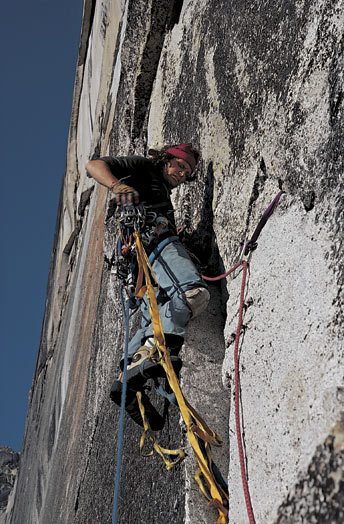
Kim Schmitz on the first ascent of Zenith (VI A4 5.8, 1,800′) in 1978. Schmitz was Bridwell’s partner for his first new route on El Cap, the Aquarian Wall, which they established in 1971.
[Photo] Jim Bridwell
7 p.m.: We stood for a moment on the top; I dimly remember a sky golden with smog. Then John reminded us that there were only a few hours left until closing time, and we began to run down the East Ledges.
Just as my feet struck the pavement, night fell and the moon once more illuminated the great stone. My EBs had filled with gravel on the descent, but I’d been unwilling to stop. I hobbled to the car. I wouldn’t be able to wear shoes again for three days.
Friends had stationed a scout along the way, who screamed, “They’re back!” and raced ahead of us to the bar; we were met at the door with more drinks than I could hold. But my best memory came from the next day, when Warren Harding, the man who had done the first ascent of the Nose, gave me his fervent congratulations. I thanked him, then limped toward the cafeteria to steal some coffee.
Sea of Dreams: October 1978
“I guess it’s like a mountain side / You gotta climb it to the top / Floating in a sea of dreams / The only thing that you can see / Is the view above the clouds.” I took the name from the Electric Light Orchestra album and picked out the line using a Questar telescope I borrowed from the Park Service. On the wall each morning we’d discuss vivid dreams that came to us partly because of the music or other influences. I believed in prophetic dreams; once I dreamed of falling off a ledge and spreading my arms out like a giant swallow. When I saw that same ledge, awake, on the P.O. Wall, you can bet I was careful.
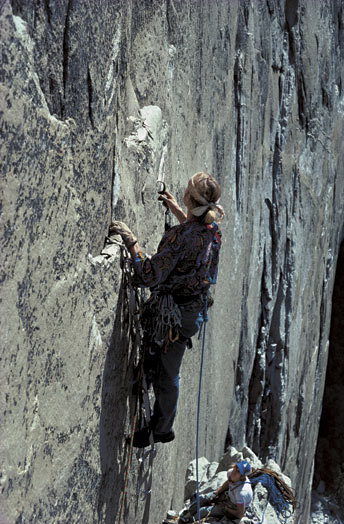
Dave Diegelman starting the Hook or Book pitch (A5) on the first ascent of Sea of Dreams (VI 5.9 A5) in 1978. The route included nine A5 pitches; Bridwell recalls using his hearing more than other senses on the route, “riding the waves of sound and movement and concentration” to the top.
[Photo] Jim Bridwell
Dale Bard, Dave Diegelman and I were exploring the edges of our perception and the standards for big walls. As we went, we had a competition to see if we could drill less than forty holes. Nine pitches were A5. Moving over tiny features as the wall seemed to undulate below me and pool into mirages in the summer heat, I had to control my fear–and not overtest placements that barely held my weight. I tried to listen to the rock and the pitons, to use my hearing more than any other senses. I developed a half-blind rhythm: step on the piece, head down, then look up at it, see what it’s doing, move up, set another piece, again and again, riding the waves of sound and movement and concentration toward the top.
In the end I placed no bolts on any of my pitches, except for on one belay, where we had six RURPs as an anchor: Dale wouldn’t come up unless we placed a bolt–which pissed me off, even if it was understandable. Altogether we drilled only thirty-nine holes. Today there are nearly 200.
From my bird’s eye view at the top of the wall, anything now seemed possible. If I could imagine a route, I could climb it. Climbing had become a cause to live for–a way to prove the freedom of my mind.
Cerro Torre: January 3-4, 1979
In your most chaotic nightmares you’d create Cerro Torre: a cold, desolate tower, high above a glacier; storms that can last thirty days; winds over 100 miles per hour; and rime ice formations more than 100 feet high. It was a place that stretched the boundaries of my imagination even to conceive.
I prepared myself to succeed at almost any cost. When my carefully chosen team of Mike Graham and John Bachar, two of the era’s strongest climbers, bailed, I talked a hitchhiking American, Steve Brewer, into joining me on an alpine-style attempt of the Compressor Route. By climbing fast we’d make ourselves moving targets, at least, for the icefall and the weather. We took the minimum amount of clothing (jacket, pants, sleeping bags), food (oatmeal, sugar, soup), equipment (twenty-five pitons and nuts, twenty-five carabiners, six ice screws, a small bolt kit, two nine-mil ropes) and four of Ray Jardine’s newly created Friends.
Steve had a way of standing around, slackjawed, that might have warned me about certain peculiarities in his character. The most stubborn person I’d ever met, he refused to lengthen the slings on his jumars for increased speed.
“Nope,” he said. “I have my ways and they work for me.”
But a summer in Peru had made him a good ice climber, and he led the lower ice pitches, placing a token screw every 150 feet as I simuled after him. I took the lead whenever the pitches were rock, mixed or aid. Sometimes I had to climb offwidths without protection, their inner surfaces shimmering with ice. As we rested below an overhang, ice shattered toward us. We smeared ourselves against the wall until the shards had passed, and only my heartbeat sounded in my ears. Crystals floated through the blue sky like tiny stars.
More ice hung above us; there was no way of knowing when it might let go. I scooted up the chimney. As we clipped up a long diagonal bolt ladder, the evening light made the harsh landscape around us turn to warmer colors of red and gold. We’d climbed 3,500 feet, higher on Cerro Torre than anyone else had in a day. That night we chopped out an ice ledge and bivied amid the ice towers. Starlight illuminated the surreal, glassy formations. I woke periodically to check the sky. The west wind now blew with signs of storm. We had no fixed rope, no bivy sacks–only two ropes and food enough for one bivy.
As the wind turned to a howl, we began to race the tempest, passing ropes and racks that hung from the wall, evidence of previous retreats. Near the summit I had to chop away six to twelve inches of ice to get to the bolts. Clouds circled above us. Maestri’s compressor appeared, an ugly 300-pound hunk of machinery, and I marveled at the effort it must have taken to muscle it up this beautiful spire. Seven broken bolts led up and to the right toward eighty feet of nearly blank granite. I went left, using knifeblades, copperheads, and where there was no crack, placing aluminum dowels in hand-drilled holes. At last I chopped a groove in an icy crack and set a Friend. To my surprise, it held. I traversed left, free climbing, with my feet on steep friction and my hammer pick in the ice above, and pulled onto the summit snowfield.
Steve soon followed and we shook hands, hugged, and got the hell out of there. The wind was sixty miles per hour and rising while we rappelled over the same ice pillars that had threatened us on the ascent. From our bivy, we watched squalls dart across the deep purple and slate-colored sky.
The morning brought more wind and a world hidden in white. The glacier was a pale flicker below us, between the swirling clouds. On the descent, down-clipping bolts with the same complete anxiety, I felt a relentless deja vu. Suddenly panic: the hammer loop ripped apart and I seemed to watch myself fall, an odd, flailing figure silhouetted against the snow. Then–wham–I reached the end of the rope, and it seemed to stretch forever (and there was time for a thousand thoughts, about my new wife, Peggy, on the East Coast, serving up breakfasts at Micky D.’s to help pay for my adventure and Lord knows she doesn’t do mornings and will I see my unborn child and will I go all the way to the ground and is this how Jim Baldwin felt and why am I screaming when I know it doesn’t do any good, why can’t I just shut up and fall) until the rope came tight and I bounced up again.
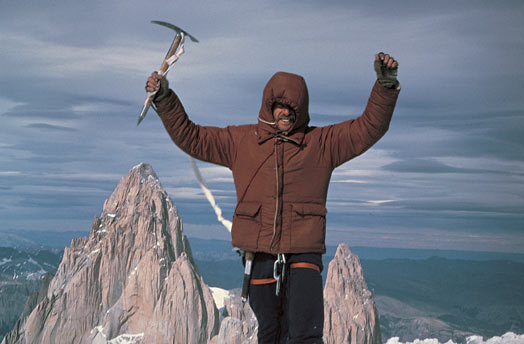
Bridwell on the summit of Cerro Torre, January 4, 1979, after making the second ascent of the Compressor Route. It was the route’s first alpine-style and first integral ascent (Cesare Maestri’s team stopped below the summit mushroom). Bridwell would take a 150-foot fall on the descent, breaking ribs and chipping an elbow.
Steve Brewer/ Jim Bridwell collection
“I’m OK!” I yelled up. “Just slipped a bit.”
I’d fallen about 150 feet, broken ribs, chipped an elbow and bruised a hip. I climbed to get my weight off the rope, clung to tiny, icy holds, waiting for Steve, and we began again, downward into more cold and more pain.
“Muy rapido, muy rapido,” the Italians shouted when we stumbled into their camp. Only half joking, I told them we moved so fast because we were frightened. Warmed by their soup and rum tea, I felt the pain fade into satisfaction: my wild, improbable vision had indeed taken form.
Zenyatta Mondatta: September 1981
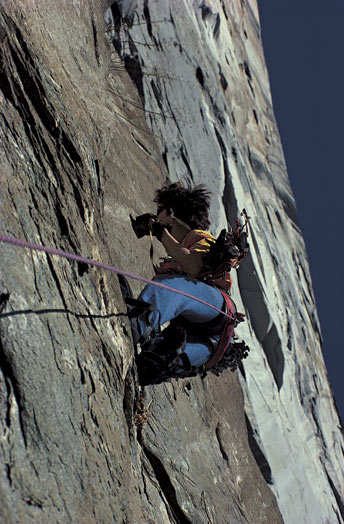
Peter Mayfield on Pitch 6, the Lightning Bolt Roof, during the first ascent of El Capitan’s Zenyatta Mondatta (VI 5.7 A4) in September 1981.
[Photo] Jim Bridwell
Back in Yosemite I learned to see lines over what at first appeared to be featureless rock, and then to trace them out. On Zenyatta Mondatta, disconnected, barely perceptible slopes made an improbable passage across an otherwise blank wall, one that could be accomplished with hooks and a single drilled hole. Fascinated, I watched the route’s intricate design unfold in three consecutive A5 leads. As Charlie Row jumared up to join me, I gazed above the belay. The overhanging rock foreshortened my view, giving no hint that anything would change. This was the beauty of the route: it gave us nothing to hope for, only short vistas of the rock before us, the here and now of our copperheads, tied-off knifeblade tips and blind hook moves, a steepness that required airy, delicate acrobatics. Later that day Charlie and Peter Mayfield lowered me gently off an overhanging pitch and stretched their arms out, until, fully extended, they just touched mine, and they could pull me onto their stance. One by one we rapped down the cord, turning like spiders on silken threads, calculating the precise arc to arrive at our bivy, where we could, all too briefly, rest.
Our small community on the route was close-knit, yet below us, Yosemite was changing. The line completed, we arrived at the base of the wall to find one of our haulbags had been stolen. I left the Valley with only twenty dollars in my pocket, uncertain whether I’d come back. The brotherhood of the ’60s and ’70s was gone.
Dance of the Woo-Li Masters: March 1981
“What the hell are you guys doing here?” That was the beginning of almost every conversation that winter in Alaska; when Mugs Stumps and I arrived in Talkeetna, it was -17 degrees F, and dogsleds were racing through the streets. I was thinking to myself that there must be a perfect ratio between a cup of coffee and an hour of bullshit. Three cups and three hours in an outdoor cafe in Grindelwald, Switzerland, had taken me and Mugs from the topic of our failed attempts on The Mooses Tooth (mine the year before with Dave Diegelman) to what suddenly seemed like a reasonable experiment: attempt the east face in the winter, when the snow and ice conditions might be better than the poor-quality rock we’d encountered during the regular season.
The caffeine buzz faded, we decided to climb something else, but when we flew over the gorge, our objective had failed to form up, so we made a quick, impulsive choice to try The Mooses Tooth after all.
As the sound of the plane became muted in the distance, the cold seemed to burn more intensely. All was silent, except for our breathing and the squeaky crunch of snow. My imagination recoiled at what lay before us. I went about setting up our tent, until I’d gathered enough courage to inspect our line. The 4,800-foot east face rose up like a hoary specter; through our little telescope a snow cornice, thirty or more feet high, overhung our chosen route. As I turned to discuss the danger with Mugs, a giant avalanche swept down the face: the cornice was gone, and the snow had been consolidated for a fast ascent.
Just as Steve and I had on Cerro Torre, Mugs and I minimized our gear for speed: eighteen pitons, a set of nuts, seven ice screws, four cams, four days’ worth of food and fuel. Mugs wanted to bring a bolt kit, but I insisted it was too heavy. The lower half of the climb consisted of avalanche chutes, and if a storm came in while we were still on the wall, retreat might be suicidal. The first clear day we timed the avalanches, trying to guess whether there was some hidden pattern. The night before we started, we drank a third of a bottle of scotch with hot tea: facing the next morning with a hangover somehow seemed easier.
With no possible protection we climbed nonstop for hundreds of feet; spindrift sloughs blinded us, and the belay anchors were illusory. As the sun warmed the ice and snow, the sloughs turned to avalanches thundering around us. Mugs breached the last few feet of sugar snow onto the ridge, but the slope would no longer hold my weight and I had to find a different line.
The next morning ice-chocked chimneys formed the gateway to the upper half of the route. Neither of us spoke of the difficulties while we forced our way up WI5, but watching each other’s rapid progress gave us hope.
On our second bivy the cold rendered our ultralight stove ineffective; apart from a few cups of water and coffee, we’d be dehydrated for the rest of the climb. Heavy snowfall, increasing spindrift avalanches and snow-covered slabs created a precarious reality that at any moment could slip out beneath us. I was gaining a deeper appreciation for Mugs. Toward the end of the third day, seeing me slumped over, nauseated with thirst, he took over the lead by headlamp. When I arrived, he was already digging a cave into a cornice, his body covered in white, like a living snowman.
At 1:30 a.m., the cave finished and some tea and coffee brewed, we collapsed into our sleeping bags. Midmorning, light returned through the cave entrance, at first faintly, through thin clouds, then intensifying to an undeniable yellow glow. The storm was past. We crawled out of the cave at 11:30 a.m. and climbed four pitches, reaching the summit at 2 p.m. After a bivy near the top, we woke to -30 degrees F. Ice formed on the top of our water as I tried to make coffee; after two cupfuls, the stove died.
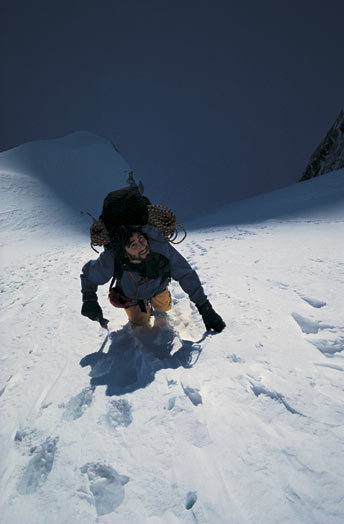
Mugs Stump on the first ascent of Dance of the Woo-Li Masters (VI 5.9 WI4+ A4, 5,000′) in March 1981. The pair, who were plagued by frigid temperatures and a malfunctioning stove, climbed the route in perfect style without a bolt kit. In 2001 Bridwell returned to add a direct start to the route: The Beast Pillar (VI 5.10b A5 WI4+ M6, 4,800′).
[Photo] Jim Bridwell
Rappel after rappel, the snow turned to crumbly rock and rotten flakes. I began to realize the potential consequences of alpine style and thought about the bolt kit we’d left at base camp. Mugs stared with wonder at one of my marginal anchors, where all I’d found was a spot for a single number three Stopper. “That’s it,” I shrugged. He later told me that he’d almost unclipped from the anchor, only to decide a quick death was more appealing than a slow one in case it failed as I rapped. Each time we weighted the rope was a gamble; at one point I stopped and hung motionless, overwhelmed with a rush of sad love for my family at home. My son, whom I’d named after Layton, was almost two years old.
When we returned to our base-camp tent, we laughed and joked and drank hot liquids, but something haunted us: the purity and success of our ascent might not have been a result of our commitment to a bold vision, but rather a unique combination of weather and conditions. Our survival might have been simply luck: the cornice that fell at the right instance, the avalanches that came so close.
Some Native Americans believe that crazy people are blessed by the Great Spirit. Mugs and I never climbed with each other again. Maybe we thought we were too dangerous together, or maybe we knew we could go to hell and come back with devil’s tails.
The Big Chill: August 1987
I didn’t always leave the bolt kit behind. When I turned a corner on The Big Chill, a new route on Half Dome I was opening with Peter Mayfield, Steve Bosque and Sean Plunkett, my heart sank. The angle from which I’d examined the dome through the telescope had been deceptive: there were no cracks. Thirteen times the drill punctured the skin of the rock. Each hole left a scar on my soul.
When the others joined me, I explained where the next pitch could go, so we could avoid more drilling. Doubtful, but trusting, Steve spent hours figuring out each placement. But for once we weren’t thinking about speed. A first ascent is an artistic creation, the only moment when our imagination can work with original stone. It could only be done right once.
As the day began to turn to evening, Steve hollered down, “This was the way to go!”
Cerro Standhardt/Desmochada: January-February 1988
“It looks like vertical and overhanging ice, and I want the first four leads,” Jay Smith said; he’d just returned from soloing around the corner to look at the route, while Greg Smith and I cooked.
“Judging by your description,” I said, “we won’t come to blows over it.”
Jay made a small grin. “It will come to blows. It’s a funnel and there’s no place for you to hide.”
I looked over at Greg; the birdlike frame that made him such a talented rock climber suddenly seemed fragile to me. But I was convinced that faith and courage were enough. I had created all the right pictures in my head, and now was the time for them to become real.
“We’ll make a place to hide,” I said, “by hanging the packs horizontally over our heads.”
“We’ll find out tomorrow,” Jay said.

Copperheads after a particularly exciting pitch during the first ascent of The Big Chill (VI 5.9 A4) in 1988. The route, on the right side of Half Dome, was the first to employ the PDH (“Pretty Damn Hard”) and NSB (“Not So Bad”) ratings–a response to local debate about the possibility of A5.
[Photo] Jim Bridwell collection
The three of us were bivying on the col of Cerro Standhardt, the last of the three Torres to remain unclimbed. The routes up the other two, Cerro Torre and Torre Egger, had been opened siege style, with fixed ropes; we wanted to go for an alpine-style first ascent. We all knew that in Patagonia such an objective could mean putting everything on the line.
At dawn after a hasty brew up, we were off. Jay, one of the best ice climbers in North America, got his requested leads. An elevator shaft twisted above us; at the back, a narrow wall of ice bulged and curved like a carnival mirror, letting us see only fragments of what lay ahead. What was hidden remained terrifying.
“It must be all free,” Jay shouted–his war cry.
At the top of the first pitch of eighty-five-degree ice, the three of us crowded into a two-foot slot, knocking into each other as we arranged the pack over our heads. Jay began again up the glassy surface, his arms growing tense with effort.
“Ice,” he yelled, the word we’d all been dreading. A serving-platter-sized piece hit me as I tried to duck under the packs, but I was only bruised.
Jay struggled to place a screw, his crampons skittering on the thin ice. By the time he set an anchor, he was too exhausted to hold the tools. Greg’s silence told me it was my lead.
A thirty-foot ice column hung over our heads. Water dripped from curtains and ran behind it. Still shaken from the last icefall, I paused for a moment, wondering what we created and what was merely chance, whether the outcomes of our routes resulted from mere position in time. How much freedom did I really have?
I had no choice, certainly, except to keep going. The soft ice divided into thin runnels between rock ribs; in seconds my boots filled with water. Drips splattered and refroze on my clothes, then crumbled off as I moved. I kept climbing without protection; I couldn’t let myself get drenched any longer.
I worked my way carefully around the curtains, disturbing only one hanging icicle, which smashed my camera at the belay. Worn out myself, I fixed the ropes and shivered.
As the shadows lengthened, we raced the sun to the top. Jay took the last pitch. Unable to find protection, he used his body to anchor the rope. Our spirits glowed as deeply as the sky.
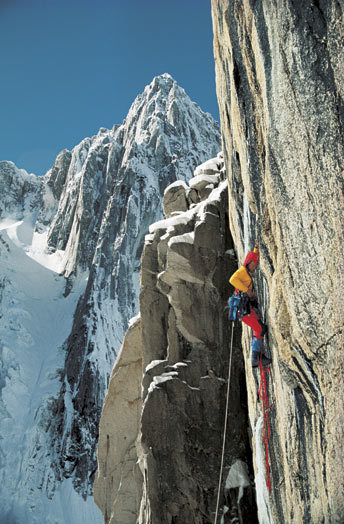
Jeff Lowe in 1989 on The Broken Tooth, Alaska Range, Alaska. Lowe attempted the route with Mark Wilford as part of a movie, with Bridwell as the cameraman. The expedition gave Bridwell a chance to scope out the Bear’s Tooth (visible in the background), which he had first seen during his ascent of The Mooses Tooth. Bridwell returned to attempt the Bear’s Tooth the next year with Peter Mayfield, then tried again in 1991 with Wilford, but was turned back both times by bad weather. In 1999, he returned with Terry Christensen, Glenn Dunmire, Brian Jonas and Brian McCray. The result was the first ascent of The Useless Emotion (VII 5.9 WI4 A4, ca. 4,700′).
[Photo] Mark Wilford
On Desmochada I realized, once again, the power of chance. Rockfall missed me by a foot on the approach. I struggled to suppress thoughts of storm. I believed that we could shape some portion of our reality, and that fear was not part of the picture I wanted to make. After three days of climbing, Jay, Glenn Dunmire and I summited on a clear, windy day. The Torres soared above, while below us the glaciers merged into the vastness of the Continental Icecap. Only a single, tiny cloud in sight, just west of the Torres… and with that thought, the wind began to blow more strongly and the cloud grew to consume the entire sky.
At each rappel, I felt as though we were casting our fates into the wind. Do we make our luck or just receive it?
The Mooses Tooth Revisited: May 2001
“Why’d you come here with me?” I asked Spencer Pfinsten, the twenty-three-year-old climber who stood beside me below the east face of The Mooses Tooth. It was our second attempt to put up a more direct start to Dance of the Woo-Li Masters. The first time I’d been in this place, with Mugs, Spencer had been a small child. At fifty-seven, I wasn’t sure I was still in condition for such a route, but a day of toproping ice had convinced Spencer that I’d be leading all the ice pitches.
“Because you’re lucky,” he said.
I thought about Mugs, who’d become one of the most visionary climbers of our era, only to die in 1992 in a crevasse on Denali. This time, I’d made a will. I’d told Peggy to sell my gear to collectors before I was forgotten. I remembered the thin and unprotectable snow and ice, the blank and rotten rock that Mugs and I had found on the Tooth. I hoped, for Spencer’s sake, that my luck would hold.
Snow fell for days; inside the tent I lay in my warm sleeping bag. And then a roar began outside. “That’s big,” I said and sat up.
As I lay back down, I heard myself shout, “Uh-oh.” I threw my knees up and braced myself as the avalanche hit the tent.
Our camp was flattened. In shock, that day and most of the next, while the storm continued, we dug out and resurrected our site.
“Luck doesn’t just happen,” I told Spencer, trying to persuade myself as well. I wanted to impart forty years of knowledge about staying alive to my neophyte friend. “You have to coordinate the elements to keep the advantage in your favor. After a storm you wait and watch for the ice- and rockfall. Watch the barometer to get an idea of how to predict the weather….”
By the end of the first day of climbing, Spencer and I had reached our previous high point; above it was the pitch that had turned us back the year before. The memory of the sixty-five degree blank rock and unconsolidated, granular snow had frightened me ever since. I tied my follow-through bowline, just as Layton had taught me when I first arrived in Yosemite, and climbed into my nightmare.
“End of rope,” Spencer yelled up to me.
“Tie another one on,” I called back. All thoughts of retreat were gone. As the light glistened up the rock, I felt like a child again, following the beautiful movement of a lizard, higher and higher. For 200 feet without protection, I tiptoed up the snow-covered slabs, imagining once more that I had that animal’s miraculous ability to stick. I slung a snow blob for an anchor, while wet avalanches reverberated down the face to the solitude of the Buckskin Glacier.
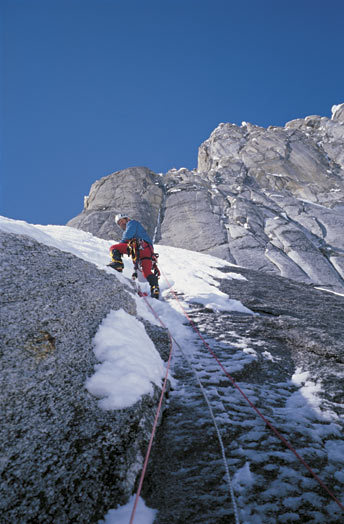
Bridwell at the start of the 200-foot runout on The Beast Pillar in 2000. Bridwell is the alpinist most familiar with the Buckskin Glacier, which also provides access to the east face of The Mooses Tooth; he has established three routes in the cirque, all of which are longer than 4,000 feet. [Photo] Spencer Pfinsten
Spencer led a downward traverse that brought us to the ice chimneys I’d climbed with Mugs. The conditions had changed our options completely. My tools and crampons pulled through slush, scraping the rock beneath. Instead of the bold alpine ice climbing Mugs and I had done, we’d have to aid. Spencer and I only had a few Birdbeaks, so I kept backcleaning them. A fall would have likely ripped out our marginal anchor. What Mugs and I had climbed in minutes now took hours.
“Arghh!” Spencer screamed the next morning. A rock had struck his arm. “I can keep going,” he said when he reached me. “I just can’t lead anymore.”
If the weather held, tomorrow had to be the day. At sunrise the sky glowed pink, suggesting an approaching storm. For now, at the top of the chimneys, we climbed into bright sunshine. Meltwater ran from the long snowfield above. At the end of sixty meters, Spencer tied on another rope. There was clearly nowhere I could place an anchor to rappel. If I continued, how would we get down? I kept going toward a narrow gully that appeared to lead into the corner Mugs and I had climbed, found some rock anchors and called down, “Rope’s fixed.” We could worry about the descent later.
I checked my altimeter. I was just below the crux pitch Mugs had led twenty years before. The solid ice he’d climbed was completely gone. I stopped to smoke a cigarette. Soon I’d have to aid a discontinuous series of loose, crumbly flakes, with no option of falling. But I knew by now this was my favorite kind of climbing: in which skill and experience are tempered by constant fear, and imagination creates new possibilities out of fate.
All the same, when I reached good anchors, I felt tired and old. Spencer’s infectious spirits cheered me for a moment, and then I was nearly crawling toward the second corner system, my legs cramped, my breath short. Shattered blocks and flakes of vertical rock, with icy hollows, gave way to solid ice at last. At the limits of my endurance, I was forced to be old-man crafty. Using every piece of knowledge I’d learned from Layton and Frank and countless other mentors and partners and wishing I were twenty-five years younger, I squeezed through the narrows behind a large snow mushroom… and then out again.
Fantastic rock and ice shapes bedazzled my eyes. There was no cornice this time, just an easy breach to the summit slope beyond. The struggle was over. As I belayed, I looked down at Spencer climbing, his hurt arm moving a little awkwardly, and relief overwhelmed me.
The Beast Pillar may be the hardest route I’ve climbed. Ever.
There are things that can be controlled and things that can’t. Somewhere in the spaces between the two, we fashion our art and our lives.

Bridwell posing for a 1986 article in Rolling Stone magazine, with Lake Tahoe in the background. [Photo] Michael Nichols